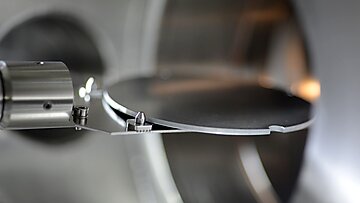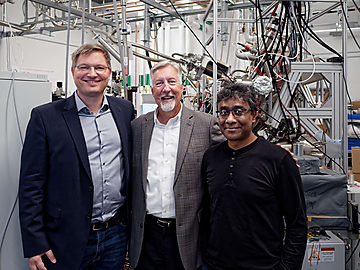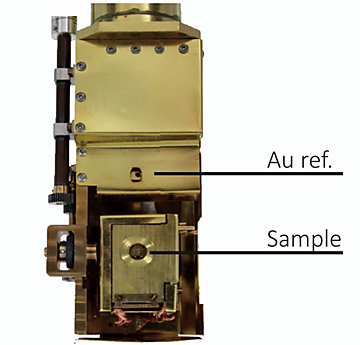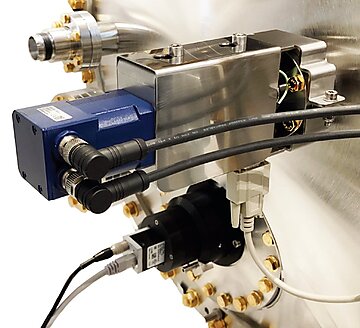Accelerating Materials Innovation
Result of the Month (ROM), May 2024
"Characterization of Buried Interfaces Using Ga Kα Hard X-Ray Photoelectron Spectroscopy (HAXPES)"
The extension of X-ray photoelectron spectroscopy (XPS) to measure layers and interfaces below the uppermost surface requires higher X-ray energies and electron energy analysers capable of measuring higher electron kinetic energies. This has been enabled at synchrotron radiation facilities and by using lab-based instruments which are now available with sufficient sensitivity for measurements to be performed on reasonable timescales. Here, we detail measurements on buried interfaces using a Ga Kα (9.25 keV) metal jet X-ray source and an EW4000 energy analyser (Scienta Omicron) in the Henry Royce Institute at the University of Manchester. Development of the technique has required the calculation of relative sensitivity factors (RSFs) to enable quantification analogous to Al Kα XPS, and here we provide further substantiation of the Ga Kα RSF library. Examples of buried interfaces include layers of memory and energy materials below top electrode layers, semiconductor heterostructures, ions implanted in graphite, oxide layers at metallic surfaces, and core–shell nanoparticles. The use of an angle-resolved mode enables depth profiling from the surface into the bulk, and is complemented with surface-sensitive XPS. Inelastic background modelling allows the extraction of information about buried layers at depths up to 20 times the photoelectron inelastic mean free path.
Scienta Omicron Newsflyer Winter 2023
Welcome to the Scienta Omicron Winter Newsflyer!
We are thrilled to bring you the latest highlights and breakthroughs in the realm of scientific innovation. In this edition of the Scienta Omicron Winter Newsflyer, join us on a journey through the fascinating discoveries, cutting-edge technologies, and collaborative efforts that define the spirit of exploration in the scientific community.
From groundbreaking research to advancements in our instrumentation, this newsletter encapsulates the essence of our commitment to pushing the boundaries of what is possible. As we delve into the cold season, we invite you to warm your curiosity with the exciting stories and developments that unfold within these pages.
Latest News
News PEAK-1.5 Now Available for Download!
We're thrilled to announce that PEAK-1.5 is now ready for download at the Scienta Omicron Customer Portal. Here's a quick overview of the new features you can expect with this release:
- New Sequence Control for easier setup of measurements
- A fresh Sequence View with Spectrum Region Summaries for better control during measurement
- Introduction of Continuous Pass Energies for optimisation of instrument resolution and data recording efficiency (requires a new software license)
- Introduction of a Detector Overexposure Monitor to protect the MCP/CMOS detector from intensity overload
Sample Manipulators
Open and Closed Cycle Sample Manipulators
When aiming at high experimental energy resolution for ARPES measurement, it is crucial to achieve ultra-low sample temperatures to quench thermal broadening. This is possible with state-of-the-art cryo manipulators reaching sample temperatures from < 3.5 K and featuring up to 6 fully motorized axes for a large range of movements. The manipulators are available as open and closed cycle. Open cycle manipulators reach lower temperature specifications and are rapidly cooled down from room temperature to 10 K in 15 min. The low He consumption below 1 l/h at ultimate temperature and the possibility to operate with liquid nitrogen at higher temperatures ensure a low operating cost. Closed cycle manipulators have no He consumption providing unlimited holding time.
Service Upgrade
PEAK Slit Control
Optimal analyser settings with remote control
In photoelectron spectroscopy measurements, there is always a trade-off between signal intensity and resolution. Optimising this balance is the key to obtaining smooth and sharp spectra within the shortest time possible. For hemispherical analysers, this trade-off is controlled by the selected entrance slit and pass energy.
PEAK Slit Control replaces manual slit changes at the analyser with a motorised and software-controlled slit. With the control of all analyser settings, easy and quick optimisation of signal intensity versus resolution is possible.
About Us
Scienta Omicron is a leading innovator in Surface Science and Nanotechnology. At our technology centres in Uppsala, Sweden and Taunusstein, Germany we develop and produce high-tech instruments. Our instruments support top researchers globally and are serviced by our four regional hubs in USA, China, Japan and Germany.
We provide state of the art instruments in Electron Spectroscopy, Scanning Probe Microscopy and Thin Film Deposition. Focusing on the race for new unique materials and solutions, in areas like – smarter batteries, next generation electronics, quantum technologies, solar energy, intelligent sensors and advanced materials, Scienta Omicron enables development of tomorrow´s materials.
THE SCIENTA GROUP: One Group, Two Leading Brands
Since 1983 the combined companies, including Scienta Omicron and Scienta Envinet (former Scienta Sensor Systems and Envinet GmbH respectively) that make up the Scienta Scientific Group have been leading the development of ultra high vacuum research and analysis equipment in the fields of Surface Science, Material Physics, UHV technology and Radiation Detection, resulting in scientific breakthroughs, Nobel Prizes and outstanding industrial equipment.









